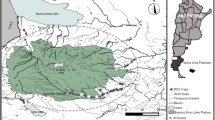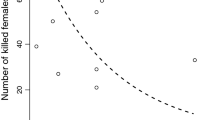Abstract
Introduced mammalian predators have had significant impacts on many native prey species. Although control of such predators for conservation management is becoming increasingly commonplace, it is often undertaken at a relatively small scale in relation to the overall predator population. Processes such as immigration mean that it remains difficult to determine the effectiveness of control measures. We investigated the impacts of feral ferret Mustela furo removal on the entire feral ferret population on Rathlin Island, UK. Removal of ferrets prior to breeding led to a substantial increase in the post-dispersal population through the enhanced survival of juveniles. Despite increased numbers, overwinter survival remained high, potentially aided by the reduced territoriality shown by this feral species compared to wild carnivores. The response of this ferret population to control is a further illustration of the complex ecological processes and outcomes arising from the anthropogenic disruption of wildlife populations. It highlights how partial or localised management may prove ineffective, and at worst might exacerbate the problems that management was designed to avert.




Similar content being viewed by others
References
Anonymous (2007) Rathlin seabird colony survey 2007. Allen & Mellon Environmental Ltd, UK
Baker PJ, Funk SM, Harris S, White PCL (2000) Flexible spatial organization of urban foxes, Vulpes vulpes, before and during an outbreak of sarcoptic mange. Anim Behav 59:127–146
Balharry D (1993) Social organization in martens: an inflexible system? In: Dunstone N, Gorman MC (eds) Mammals as predators. Clarendon, Oxford, pp 321–345
Barlow ND, Norbury GL (2001) A simple model for ferret population dynamics and control in semi-arid New Zealand habitats. Wildl Res 28:87–94
Barlow ND, Kean JM, Briggs CJ (1997) Modelling the relative efficacy of culling and sterilisation for controlling populations. Wildl Res 24:129–141
Bertolino S, Genovesi P (2003) Spread and attempted eradication of the grey squirrel (Sciurus carolinensis) in Italy, and consequences for the red squirrel (Sciurus vulgaris) in Eurasia. Conserv 109:351–358
Bino G, Dolev A, Yosha D, Guter A, King R, Saltz D, Kark S (2010) Abrupt spatial and numerical responses of overabundant foxes to a reduction in anthropogenic resources. J Appl Ecol. doi:10.1111/j.1365-2664.2010.01882.x
Blandford PRS (1987) Biology of the polecat Mustela putorius–a literature review. Mammal Rev 17:155–198
Bodey TW, Bearhop S, McDonald RA (2010) The diet of an invasive alien predator the feral ferret Mustela furo: implications for the conservation of ground nesting birds. Eur J Wildl Res. doi:10.1007/s10344-010-0404-y
Bolton M, Tyler G, Smith K, Bamford R (2007) The impact of predator control on lapwing Vanellus vanellus breeding success on wet grassland nature reserves. J Appl Ecol 44:534–544
Bonesi L, Palazon S (2007) The American mink in Europe: status, impacts, and control. Biol Conserv 134:470–483
Bremner A, Park K (2007) Public attitudes to the management of invasive non-native species in Scotland. Biol Conserv 139:306–314
Byrom AE (2002) Dispersal and survival of juvenile feral ferrets Mustela furo in New Zealand. J Appl Ecol 39:67–78
Caley P, McElrea LM, Hone J (2002) Mortality rates of feral ferrets (Mustela furo) in New Zealand. Wildl Res 29:323–328
Chapman DG (1951) Some properties of the hypergeometric distribution with applications to zoological censuses. U Calif Publ Stats 1:131–160
Clapperton BK, Byrom A (2005) Feral ferret. In: King CM (ed) The handbook of New Zealand mammals, 2nd edn. Oxford University Press, Melbourne, pp 294–308
Courchamp F, Langlais M, Sugihara G (2000) Rabbits killing birds: modelling the hyperpredation process. J Anim Ecol 69:154–164
Dowding JE, Murphy EC (2001) The impact of predation by introduced mammals on endemic shorebirds in New Zealand: a conservation perspective. Biol Conserv 99:47–64
Findlay CS, Houlahan J (1997) Anthropogenic correlates of species richness in southeastern Ontario wetlands. Conserv Biol 11:1000–1009
Frey SN, Conover MR (2007) Influence of population reduction on predator home range size and spatial overlap. J Wildl Manag 71:303–309
Gese EM (1998) Response of neighboring coyotes (Canis latrans) to social disruption in an adjacent pack. Can J Zool 76:1960–1963
Greentree C, Saunders G, McLeod L, Hone J (2000) Lamb predation and fox control in south-eastern Australia. J Appl Ecol 37:935–943
Greenwood RJ, Arnold PM, McGuire BG (1990) Protecting duck nests from mammalian predators with fences, traps, and a toxicant. Wildl Soc Bull 18:75–82
Herr J, Schley L, Roper TJ (2009) Socio-spatial organization of urban stone martens. J Zool 277:54–62
Janzen DH (1986) The eternal external threat. In: Soulé ME (ed) Conservation biology: the science of scarcity and diversity. Sinauer Assoc, Sunderland, pp 286–303
Jiménez JE, Conover MR (2001) Ecological approaches to reduce predation on ground-nesting gamebirds and their nests. Wildl Soc Bull 29:62–69
Johnson DDP, Macdonald DW, Dickman AJ (2000) An analysis and review of models of the sociobiology of the Mustelidae. Mammal Rev 30:171–196
Keedwell RJ, Maloney RF, Murray DP (2002) Predator control for protecting kaki (Himantopus novaezelandiae)–lessons from 20 years of management. Biol Conserv 105:369–374
Kenward R (2001) A Manual for Wildlife Radio Tagging. Academic Press, London
King CM, Powell RA (2006) The natural history of weasels and stoats: ecology, behaviour and management, 2nd edn. Oxford University Press, UK
King CM, O’Donnell CFG, Phillipson SM (1994) Monitoring and control of mustelids on conservation lands. Part 2: field and workshop guide. Dept Cons Tech Ser 4:36
King CM, McDonald RM, Martin RD, MacKenzie DI, Tempero GW, Holmes SJ (2007) Continuous monitoring of predator control operations at landscape scale. Ecol Manag Restor 8:133–139
King CM, McDonald RM, Martin RD, Dennis T (2009) Why is the eradication of invasive mustelids so difficult? Biol Conserv 142:806–816
Kinnear JE, Sumner NR, Onus ML (2002) The red fox in Australia—an exotic predator turned biocontrol agent. Biol Conserv 108:335–359
Kitchener AC, Birks JDS (2008) Ferret. In: Harris S, Yalden DW (eds) Mammals of the British isles: handbook, 4th edn. The Mammal Society, Southampton, pp 485–487
Lahti DC (2001) The “edge effect on nest predation” hypothesis after twenty years. Biol Conserv 99:365–374
Lockwood JL, Hoopes MF, Marchetti MP (2007) Invasion Ecology. Blackwell, UK
Long JL (2003) Introduced mammals of the world. CABI Publishing, Wallingford
Macdonald DW, Harrington LA (2003) The American mink: the triumph and tragedy of adaptation out of context. N Z J Zool 30:421–441
McDonald RA, Harris S (2002) Population biology of stoats Mustela erminea and weasels Mustela nivalis on game estates in Great Britain. J Appl Ecol 39:793–805
McDonald RA, Vaughan N (1999) An efficient way to prepare mammalian skulls and bones. Mammal Rev 29:265–266
McDonald RA, Delahay RJ, Carter SP, Smith GC, Cheeseman CL (2008) Perturbing implications of wildlife ecology for disease control. Trend Ecol Evol 23:53–56
McKinney ML, Lockwood JL (1999) Biotic homogenization: a few winners replacing many losers in the next mass extinction. Trend Ecol Evol 14:450–453
Medina FM, Martin A (2009) A new invasive species in the Canary Islands: a naturalized population of ferrets Mustela furo in La Palma Biosphere Reserve. Oryx 44:41–44
Minta SC (1993) Sexual differences in spatiotemporal interaction among badgers. Oecologia 96:402–409
Mitchell PI, Newton SF, Ratcliffe N, Dunn TE (2004) Seabird populations of Britain and Ireland: results of the ‘Seabird 2000’ census 1999–2002. Poyser, London
Morrison SA, Macdonald N, Walker K, Lozier L, Shaw MR (2007) Facing the dilemma at eradication’s end: uncertainty of absence and the Lazarus effect. Front Ecol Environ 5:271–276
Murphy EC, Dowding JE (1994) Range and diet of stoats (Mustela erminea) in a New Zealand beech forest. N Z J Ecol 18:11–18
Norbury GL, Norbury DC, Heyward RP (1998) Space use and denning behaviour of wild ferrets (Mustela furo) and cats (Felis catus). N Z J Ecol 22:149–159
Oksanen L (2001) Logic of experiments in ecology: is pseudoreplication a pseudoissue? Oikos 94:27–38
Oppel S, Beaven BM, Bolton M, Vickery J, Bodey TW (in press) Eradication of invasive mammals on islands inhabited by humans and domestic animals. Conserv Biol. doi: 10.1111/j.1523-1739.2010.01601.x
Otis DL, Burnham KP, White GC, Anderson DR (1978) Statistical inference from capture data on closed animal populations. Wildl Monogr 62
Parkes J, Panetta D (2009) Eradication of invasive species: progress and emerging issues in the 21st century. In: Clout MN, Williams PA (eds) Invasive species management. A handbook of principles and techniques. Oxford University Press, Oxford, pp 47–60
Powell RA (1994) Structure and spacing of Martes populations. In: Buskirk SW, Harested AS, Raphael MG, Powell RA (eds) Martens, sables, and fishers, biology and conservation. Cornell University Press, Ithaca, pp 101–121
Quinn JH, Whisson DA (2005) The effects of anthropogenic food on the spatial behaviour of small Indian mongooses (Herpestes javanicus) in a subtropical rainforest. J Zool 267:339–350
Ragg JR (1997) Tuberculosis (Mcyobacterium bovis) epidemiology and the ecology of ferrets (Mustela furo) on New Zealand farmland. PhD thesis, University of Otago, Dunedin
Ragg JR (1998) The denning behaviour of feral ferrets (Mustela furo) in a pastoral habitat, South Island, New Zealand. J Zool 246:471–477
Ragg JR, Mackintosh CG, Moller H (2000) The scavenging behaviour of ferrets (Mustela furo), feral cats (Felis domesticus), possums (Trichosurus vulpecula), hedgehogs (Erinaceus europaeus) and harrier hawks (Circus approximans) on pastoral farmland in New Zealand: Implications for bovine tuberculosis transmission. N Z Vet J 48:166–175
Rooney SM, Wolfe A, Hayden TJ (1998) Autocorrelated data in telemetry studies: time to independence and the problem of behavioural effects. Mammal Rev 28:89–98
Russell JC, Abdelkrim J, Fewster RM (2009) Early colonisation population structure of a Norway rat island invasion. Biol Invasions 11:1557–1567
Sargeant AB (1972) Red fox spatial characteristics in relation to waterfowl predation. J Wildl Manag 36:225–236
Seber GAF (1973) The estimation of animal abundance and related parameters. Griffin, London
Sinclair ARE (1996) Mammal populations: fluctuation, regulation, life history theory and their implications for conservation. In: Floyd RB, Sheppard AW, De Barro PJ (eds) Frontiers of Population Ecology. CSIRO, Melbourne, pp 127–154
Sinclair ARE, Pech RP, Dickman CR, Hik D, Mahon P, Newsome AE (1998) Predicting effects of predation on conservation of endangered prey. Conserv Biol 12:564–575
Smith RK, Pullin AS, Stewart GB, Sutherland WJ (2010) Effectiveness of predator removal for enhancing bird populations. Conserv Biol 24:820–829
Sutherland WJ, Pullin AS, Dolman PM, Knight TM (2004) The need for evidence-based conservation. Trend Ecol Evol 19:305–308
Towns DR, Broome KG (2003) From small Maria to massive Campbell: forty years of rat eradications from New Zealand islands. N Z J Zool 30:377–398
Veitch CR, Clout MN (2002) Turning the tide: the eradication of invasive species In: proceedings of the international conference on eradication of island invasives. IUCN, Gland, Switzerland and Cambridge, UK
Vitousek PM, Mooney HA, Lubchenco J, Melillo JM (1997) Human domination of Earth’s ecosystems. Science 277:494–499
White GC, Burnham KP (1999) Program MARK: survival estimation from populations of marked animals. Bird Study 46(S):120–138
Wolff A, Dieuleveut T, Martin JL, Bretagnolle V (2002) Landscape context and little bustard abundance in a fragmented steppe: implications for reserve management in mosaic landscapes. Biol Conserv 107:211–220
Woodroffe R, Donnelly CA, Cox DR, Bourne FJ, Cheeseman CL, Delahay RJ, Gettinby G, McInerney JP, Morrison WI (2006) Effects of culling on badger Meles meles spatial organization: implications for the control of bovine tuberculosis. J Appl Ecol 43:1–10
Zabala J, Zuberogoitia I, González-Oreja JA (2010) Estimating costs and outcomes of invasive American mink (Neovison vison) management in continental areas: a framework for evidence based control and eradication. Biol Invasions. doi:10.1007/s10530-010-9690-2
Zubergoitia I, Zabala J, Martínez JA (2006) Evaluation of sign surveys and trappability of American mink: management consequences. Folia Zool 55:257–263
Acknowledgments
TWB was supported by a PhD studentship through the Quercus partnership between Northern Ireland Environment Agency & Queen’s University Belfast. We thank the residents and landowners of Rathlin for allowing access; Liam McFaul, Rosalind Kennerley, Jonathan Reeves, Oisin Sweeney, Rory Finlay, Marc Ruddock and David Tosh for assistance with fieldwork; and three anonymous reviewers for improving the manuscript. All fieldwork on animals was approved by the Queen’s University, Belfast ethics committee, and scientific procedures on animals were carried out under Home Office licence where appropriate.
Author information
Authors and Affiliations
Corresponding author
Rights and permissions
About this article
Cite this article
Bodey, T.W., Bearhop, S. & McDonald, R.A. Localised control of an introduced predator: creating problems for the future?. Biol Invasions 13, 2817–2828 (2011). https://doi.org/10.1007/s10530-011-9965-2
Received:
Accepted:
Published:
Issue Date:
DOI: https://doi.org/10.1007/s10530-011-9965-2




